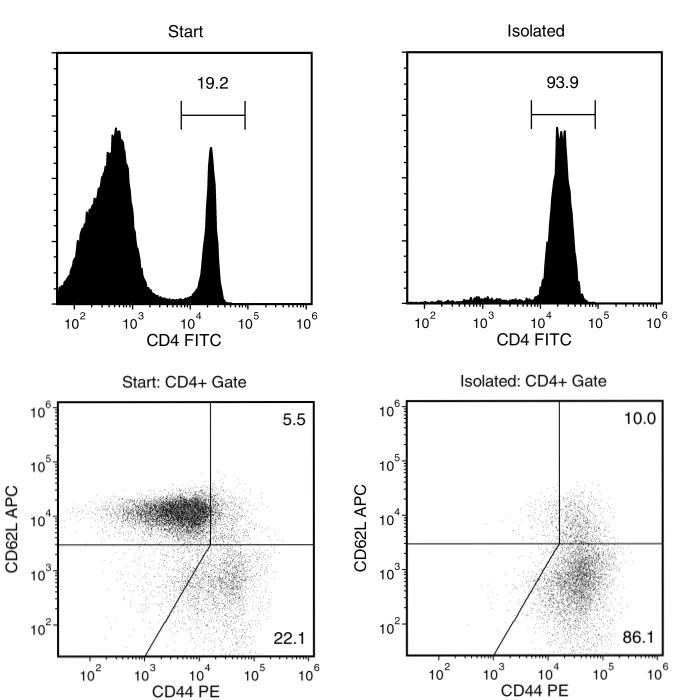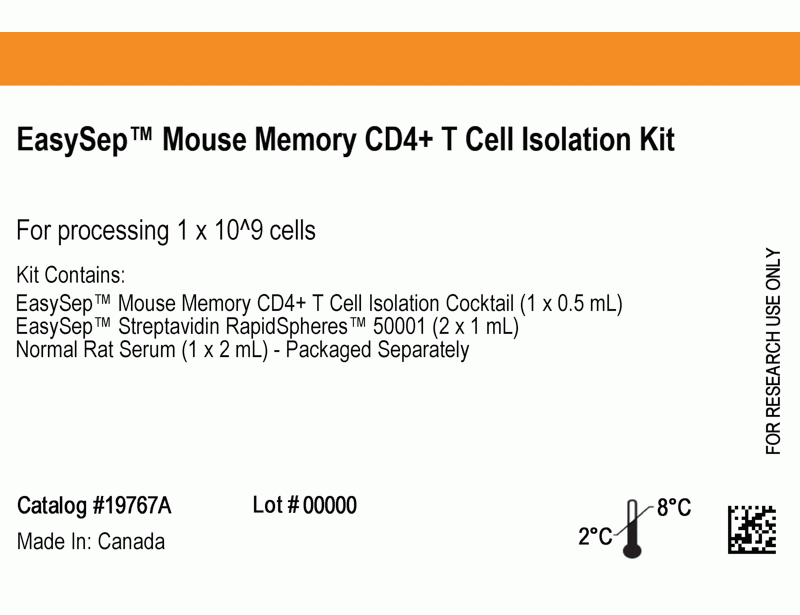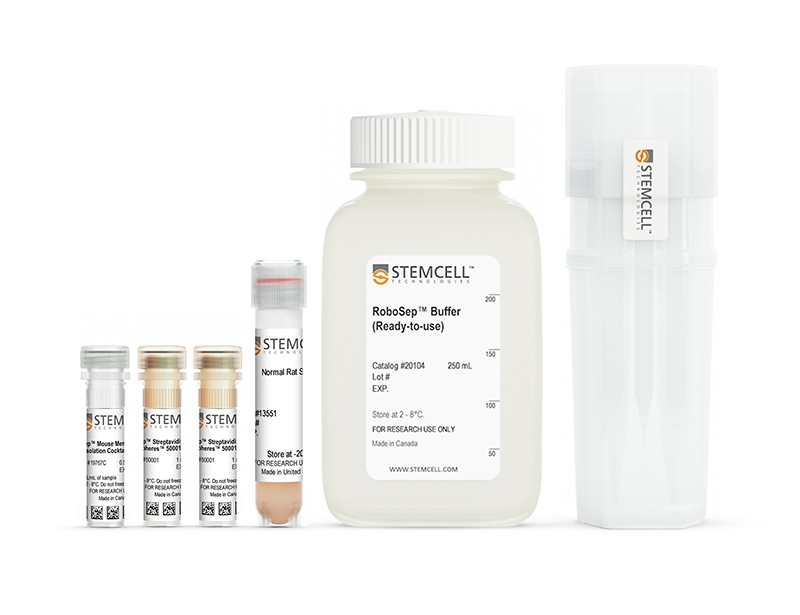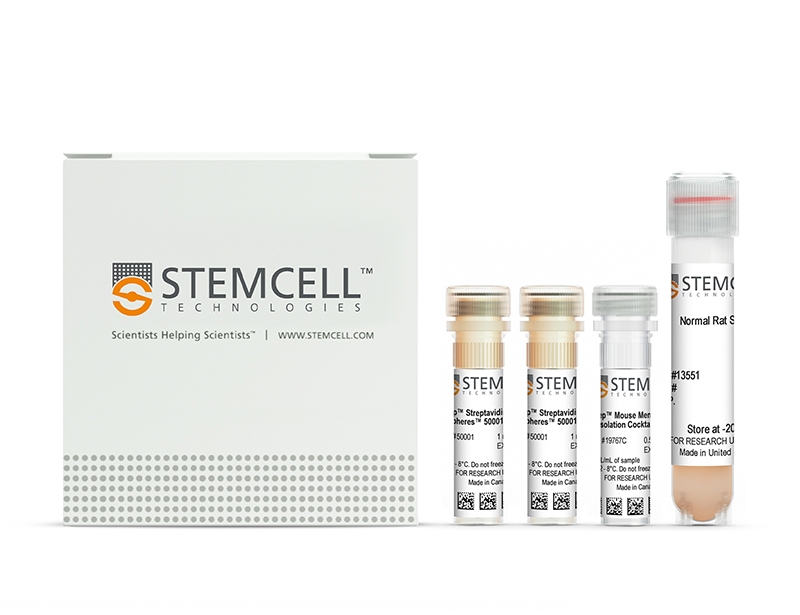EasySep™ Mouse Memory CD4+ T Cell Isolation Kit
27.5-Minute cell isolation kit using immunomagnetic negative selection
概要
The EasySep™ Mouse Memory CD4+ T Cell Isolation Kit is designed to isolate pan-memory CD4+ T cells from single-cell suspensions of splenocytes or other tissues by negative selection. Unwanted cells are targeted for removal with biotinylated antibodies directed against non-memory CD4+ T cells (CD8, CD11b, CD11c, CD19, CD24, CD45R, CD45RB, CD49b, CD105 and TCRγ/δ) and streptavidin-coated magnetic particles (RapidSpheres™ ). Labeled cells are separated using an EasySep™ magnet without the use of columns. Desired cells are poured off into a new tube.
Learn more about our next-generation EasySep™ mouse cell isolation kits, featuring RapidSphere™ technology.
Learn more about our next-generation EasySep™ mouse cell isolation kits, featuring RapidSphere™ technology.
Advantages
• Fast, easy-to-use and column-free
• Up to 96% purity
• Untouched, viable cells
• Up to 96% purity
• Untouched, viable cells
Components
- EasySep™ Mouse Memory CD4+ T Cell Isolation Kit (Catalog #19767)
- EasySep™ Mouse Memory CD4+ T Cell Isolation Cocktail, 0.5 mL
- EasySep™ Streptavidin RapidSpheres™ 50001, 2 x 1 mL
- Normal Rat Serum, 2 mL
- RoboSep™ Mouse Memory CD4+ T Cell Isolation Kit (Catalog #19767RF)
- EasySep™ Mouse Memory CD4+ T Cell Isolation Cocktail, 0.5 mL
- EasySep™ Streptavidin RapidSpheres™ 50001, 2 x 1 mL
- Normal Rat Serum, 2 mL
- RoboSep™ Buffer (Catalog #20104)
- RoboSep™ Filter Tips (Catalog #20125)
Magnet Compatibility
• EasySep™ Magnet (Catalog #18000)
• “The Big Easy” EasySep™ Magnet (Catalog #18001)
• EasyEights™ EasySep™ Magnet (Catalog #18103)
• RoboSep™-S (Catalog #21000)
Subtype
Cell Isolation Kits
Cell Type
T Cells, T Cells, CD4+
Species
Mouse
Sample Source
Other, Spleen
Selection Method
Negative
Application
Cell Isolation
Brand
EasySep, RoboSep
Area of Interest
Immunology
技术资料
| Document Type | 产品名称 | Catalog # | Lot # | 语言 |
|---|---|---|---|---|
| Product Information Sheet | EasySep™ Mouse Memory CD4+ T Cell Isolation Kit | 19767 | All | English |
| Product Information Sheet | RoboSep™ Mouse Memory CD4+ T Cell Isolation Kit | 19767RF | All | English |
| Safety Data Sheet 1 | EasySep™ Mouse Memory CD4+ T Cell Isolation Kit | 19767 | All | English |
| Safety Data Sheet 2 | EasySep™ Mouse Memory CD4+ T Cell Isolation Kit | 19767 | All | English |
| Safety Data Sheet 3 | EasySep™ Mouse Memory CD4+ T Cell Isolation Kit | 19767 | All | English |
| Safety Data Sheet 1 | RoboSep™ Mouse Memory CD4+ T Cell Isolation Kit | 19767RF | All | English |
| Safety Data Sheet 2 | RoboSep™ Mouse Memory CD4+ T Cell Isolation Kit | 19767RF | All | English |
| Safety Data Sheet 3 | RoboSep™ Mouse Memory CD4+ T Cell Isolation Kit | 19767RF | All | English |
数据及文献
Data

Figure 1. Typical EasySet™ Mouse Memory CD4+ T Cell Isolation Profile
Starting with mouse splenocytes, the memory CD4+ T cell (CD4+CD62L high CD44 high/int central memory and CD4+CD62L-CD44 high/int effector memory) content of the isolated fraction typically ranges from 78 - 96%. In the example above, the final purities of the start and isolated fractions are 5.3% and 90.2%, respectively.
Publications (1)
Nature communications 2020
T cell-intrinsic role for Nod2 in protection against Th17-mediated uveitis.
Abstract
Abstract
Mutations in nucleotide-binding oligomerization domain-containing protein 2 (NOD2) cause Blau syndrome, an inflammatory disorder characterized by uveitis. The antimicrobial functions of Nod2 are well-established, yet the cellular mechanisms by which dysregulated Nod2 causes uveitis remain unknown. Here, we report a non-conventional, T cell-intrinsic function for Nod2 in suppression of Th17 immunity and experimental uveitis. Reconstitution of lymphopenic hosts with Nod2-/- CD4+ T cells or retina-specific autoreactive CD4+ T cells lacking Nod2 reveals a T cell-autonomous, Rip2-independent mechanism for Nod2 in uveitis. In naive animals, Nod2 operates downstream of TCR ligation to suppress activation of memory CD4+ T cells that associate with an autoreactive-like profile involving IL-17 and Ccr7. Interestingly, CD4+ T cells from two Blau syndrome patients show elevated IL-17 and increased CCR7. Our data define Nod2 as a T cell-intrinsic rheostat of Th17 immunity, and open new avenues for T cell-based therapies for Nod2-associated disorders such as Blau syndrome.



